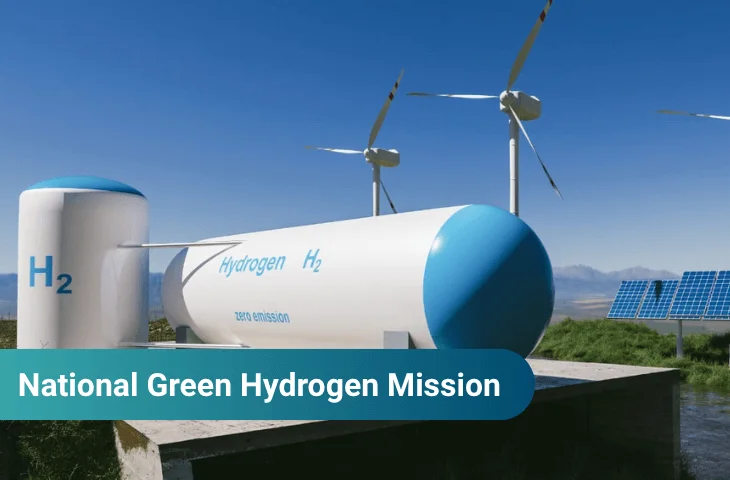The National Green Hydrogen Mission is an initiative by the Indian government approved on 4th January 2023. The vision of this scheme is to make India a global hub for green hydrogen production, usage, and export. The mission aligns with India’s commitment to a clean energy transition, reducing fossil fuel dependency, decarbonizing the economy, and promoting domestic technology development.
Green hydrogen is a clean fuel produced by electrolysis of water using renewable energy, making it nearly emission-free. Unlike conventional hydrogen, which is derived from coal or natural gas (brown or grey hydrogen), green hydrogen is environmentally sustainable.
The mission aims to leverage India’s abundant renewable energy resources such as solar and wind to produce green hydrogen for industrial, mobility, and energy applications.
Why has India launched the National Green Hydrogen Mission?
India’s energy landscape heavily relies on imported fossil fuels, which impacts energy security and increases economic vulnerability. The mission is designed to address these challenges while also achieving global climate goals.
- Reducing Fossil Fuel Imports
- Decarbonizing the Economy
- Economic Growth
- Technological Leadership
What are the Key Objectives and Targets of the Mission?
The National Green Hydrogen Mission has clear objectives and quantifiable targets to be achieved by 2030.
Objectives:
- Global Hub: Establish India as a global center for production, usage, and export of green hydrogen.
- Fossil Fuel Reduction: Reduce dependence on imported fossil fuels and feedstock.
- Economic Development: Encourage investments, promote local manufacturing, and create employment opportunities.
- Decarbonization: Mitigate an estimated 50 million metric tonnes (MMT) of CO2 emissions per year.
Key Targets by 2030:
| Target | Goal |
| Green Hydrogen Production | 5 MMT per annum |
| Renewable Energy Capacity | 125 GW |
| Total Investment | ₹8 lakh crore |
| Employment Generation | Over 6 lakh jobs |
| CO2 Emission Reduction | 50 MMT per year |
What is the SIGHT Programme and How does it Support the Mission?
The Strategic Interventions for Green Hydrogen Transition (SIGHT) is a flagship initiative under the Mission, aimed at financially incentivizing production and manufacturing activities.
| Component | Details |
| Outlay | ₹17,490 crore until 2029-30 |
| Incentives Provided | Electrolyzer Manufacturing: Support for domestic production of critical equipment Green Hydrogen Production: Incentives to promote commercial-scale hydrogen production |
| Eligibility | Projects must use government-approved equipment that meets specified quality and performance standards |
Green Hydrogen Hubs
To facilitate large-scale production and utilization, the mission focuses on developing Green Hydrogen Hubs.
- Identification: Regions capable of supporting green hydrogen activities will be identified.
- Infrastructure Support: Development of pipelines, storage, and distribution networks.
- Initial Phase: At least two hubs will be set up.
- Budget: ₹400 crore allocated for hubs and related projects until 2025-26.
Also Check: List of Government Schemes of India
Pilot Projects to Support the Mission
Pilot projects play a crucial role in testing and scaling new technologies.
| Sector | Outlay (₹ Crore) | Timeline |
| Low Carbon Steel | 455 | Up to 2029-30 |
| Mobility | 496 | Up to 2025-26 |
| Shipping | 115 | Up to 2025-26 |
| Other Areas | Includes biomass hydrogen, decentralized energy, storage technologies | Ongoing |
How will India Develop Infrastructure for Green Hydrogen?
A strong supply chain is critical for the success of the green hydrogen economy. The mission supports:
- Transportation: Pipelines and tankers for domestic and export supply.
- Storage: Intermediate storage facilities for buffering supply and demand.
- Distribution: Last-leg distribution networks to industries and refueling stations.
Check Out: Complete List of Important Schemes for NABARD Grade A Exam
Policy Framework for National Green Hydrogen Mission
The mission promotes an enabling policy framework to facilitate green hydrogen growth:
- Renewable Energy Support: Waiver of interstate transmission charges for RE used in hydrogen production.
- Renewable Energy Banking: Ensures efficient use of solar and wind energy.
- Open Access & Connectivity: Time-bound approvals to expedite project development.
- Regulations and Standards: Development of quality standards to align with international norms.
How is Research and Skill Development being Promoted?
Research and skill development are being promoted in the following ways:
Research and Innovation:
- Strategic Hydrogen Innovation Partnership (SHIP): A public-private framework for R&D in green hydrogen.
- Dedicated Fund: Pooled resources from industry and government institutions to fund goal-oriented research.
- Focus Areas: Electrolyzers, fuel cells, storage, hydrogen-based mobility, and industrial applications.
Skill Development:
- Coordinated efforts with the Ministry of Skill Development & Entrepreneurship.
- Training programs to ensure a skilled workforce for a thriving green hydrogen sector.
Get ready to crack government job exams with leading educators
Challenges Faced by the Green Hydrogen Mission
While the National Green Hydrogen Mission is ambitious, several challenges need addressing:
- Global Nascent Stage: Green hydrogen is still an emerging technology worldwide. India must develop infrastructure and technology to meet industrial demand.
- Economic Sustainability: Current production costs of green hydrogen are high compared to conventional fuels. Cost competitiveness is essential for adoption in mobility and industrial sectors.
- Technology Development: Efficient electrolyzers, fuel cells, and storage systems are required to make the mission scalable.
- Supply Chain Creation: Pipelines, storage, and distribution networks need rapid expansion.
Why is green hydrogen important for India and the world?
Green hydrogen is not just a fuel; it is a key enabler for clean energy transition:
- Industrial Applications: Fertilizers, steel, refineries, and chemical industries can reduce carbon footprints.
- Mobility: Long-range transportation vehicles can use hydrogen fuel cells.
- Energy Storage: Acts as a medium for storing renewable energy for later use.
- Climate Goals: Helps meet global climate commitments and reduce greenhouse gas emissions.
India’s geographic advantage, with abundant sunlight and wind resources, positions it as a global leader in green hydrogen production.
How does the Mission Plan to Ensure Economic and Technological Leadership?
The mission focuses on indigenization, innovation, and market creation:
- Supporting domestic manufacturing of electrolyzers and hydrogen equipment.
- Promoting public-private partnerships for research and innovation.
- Developing regional hubs for production, storage, and export.
- Facilitating policy and regulatory frameworks to attract global investment.
Key Takeaways
| Aspect | Details |
| Mission Launch | 4th January 2023 |
| Nodal Ministry | Ministry of New & Renewable Energy (MNRE) |
| Total Outlay | ₹19,744 crore |
| Main Program | SIGHT (Strategic Interventions for Green Hydrogen Transition) |
| Green Hydrogen Target | 5 MMT/year by 2030 |
| Renewable Energy Addition | 125 GW by 2030 |
| Job Creation | 6 lakh direct & indirect jobs |
| CO2 Abatement | 50 MMT/year |
| Key Applications | Industry, mobility, energy storage |
| Initial Green Hydrogen Hubs | At least 2 hubs |
Questions Based on National Green Hydrogen Mission
- When was the National Green Hydrogen Mission approved?
A) 2020
B) 2021
C) 2022
D) 2023
E) 2024 - Which ministry is the nodal agency for the Mission?
A) Ministry of Petroleum
B) Ministry of New & Renewable Energy
C) Ministry of Environment
D) Ministry of Steel
E) Ministry of Power - What is the green hydrogen production target by 2030?
A) 2 MMT
B) 3 MMT
C) 5 MMT
D) 10 MMT
E) 15 MMT - How much renewable energy capacity is planned to support the Mission?
A) 100 GW
B) 110 GW
C) 125 GW
D) 150 GW
E) 175 GW - Which program provides financial incentives under the Mission?
A) JNNSM
B) PM-KUSUM
C) SIGHT
D) SHIP
E) ISHUP - What is the expected total investment by 2030?
A) ₹5 lakh crore
B) ₹6 lakh crore
C) ₹7 lakh crore
D) ₹8 lakh crore
E) ₹10 lakh crore - How many Green Hydrogen Hubs are planned initially?
A) 1
B) 2
C) 3
D) 5
E) 10 - Which sector is a key target for pilot projects under the Mission?
A) Steel
B) IT
C) Telecom
D) Agriculture
E) Banking - What is green hydrogen primarily produced from?
A) Coal
B) Natural gas
C) Water electrolysis using renewable energy
D) Nuclear power
E) Petroleum - Which initiative supports R&D in green hydrogen?
A) SIGHT
B) SHIP
C) PM-KUSUM
D) JNNSM
E) ISHUP
Also Read:
Answer Key
| Question Number | Answer | Question Number | Answer |
| 1 | D | 6 | D |
| 2 | B | 7 | B |
| 3 | C | 8 | A |
| 4 | C | 9 | C |
| 5 | C | 10 | B |
- MISHTI Scheme, India’s Initiative to Restore Mangrove Ecosystems
- National Green Hydrogen Mission Features, Objectives, and Benefits
- Paramparagat Krishi Vikas Yojana, Transforming India’s Organic Farming
- Mission on Integrated Development of Horticulture NHM and HMNEH
- Swachh Bharat Mission, India’s Journey Towards Cleanliness and Hygiene
- SAGY, A Step Towards Holistic Development of Indian Villages

Hi, I’m Aditi. I work as a Content Writer at Oliveboard, where I have been simplifying exam-related content for the past 4 years. I create clear and easy-to-understand guides for JAIIB, CAIIB, and UGC exams. My work includes breaking down notifications, admit cards, and exam updates, as well as preparing study plans and subject-wise strategies.
My goal is to support working professionals in managing their exam preparation alongside a full-time job and to help them achieve career growth.
